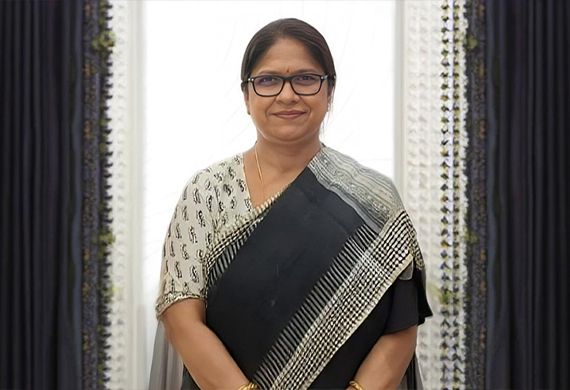
Empowering Young Innovators through Purpose-Driven Education Models
By: Silpi Sahoo, Chairperson, SAI International Education Group
Dr. Silpi Sahoo is a visionary edupreneur dedicated to fostering holistic, globally competitive education. With advanced training from Harvard and the British Council, she has earned numerous accolades for her innovative contributions to early childhood, residential, and K–12 learning in India.
In an engaging interaction with Women Entrepreneurs Review Magazine, Silpi shares her insights on the role of schools in nurturing entrepreneurial thinking, bridging education with evolving job markets, fostering mentorship, and shifting from rote learning to a culture of innovation.
How do you view the role of schools as incubators for young minds in fostering entrepreneurial thinking? What unique challenges are we facing in aligning education with the rapidly changing job market?
By teaching creativity, problem-solving, and grit to students, schools perform an instrumental role as incubators of entrepreneurial mind. SAI group institutions are the prime examples of these with SAITED (SAI Technology, Entrepreneurship, and Design) leading programmes that unite technology and entrepreneurship to develop a framework of entrepreneurial spirit. Students are empowered to resolve problems that matter, so that they may excel within an ever-changing labour market.
However, there are still challenges in aligning education with industry requirements. The speed of technological advancement tends to surpass the pace of curriculum revision, rendering students ill-equipped for new jobs. Limited access to resources in underserved areas further deepens inequalities. To address this, schools must adopt adaptable, forward-thinking curricula, exemplified by SAI’s STEM and AI initiatives, which equip students with essential digital-era skills. Industry collaborations, such as SAI’s Global Transformative AI Internships, help bridge the gap by providing hands-on experience. By fostering creativity and adaptability, schools can better prepare students for the evolving job market.
How can schools seamlessly integrate entrepreneurial skills into students’ core learning while bridging the gap between classroom education and real-world entrepreneurial experiences?
We must shift away from theoretical, discussion-based learning and into hands-on, experiential learning that incorporates entrepreneurial skills into the core curriculum. With internships and skill development included in programs like SAI Prashikshan, SAI International has been able to do exactly that, providing first-hand experience to their students even in situations with limited resources. Our UNWIND program is a student-initiated program aimed at fostering entrepreneurship and leadership, allowing students to apply what they are learning in the classroom as they work to plan events and lead teams. Less resource-rich schools could have similar opportunities by tapping into local business partnerships and online resources. Through SAI's Global Immersion Programs — we provide exposure to our students to collaborate with foreign school demonstrating how cooperation can expand horizons. Moreover, through SAI's Design Thinking Workshops, we develop the problem-solving capabilities of students and attempt to provide them with a position to think out of the box and generate innovative concepts. Schools with a focus on practical applications and partnerships with local firms can prepare students with the abilities necessary to operate in an entrepreneurial environment that frequently goes beyond the classroom.
How can schools cultivate a robust mentorship culture, particularly for students from underserved or less privileged backgrounds?
This association must have an active mentorship program— providing a platform to bring students together with experienced, working professionals, including from marginalized communities. SAI Group of schools has raised the bar with programs like Ivy League-style mentorships, in which students are paired with global experts. Online mentorship programs could be a cost-effective solution for schools with fewer resources. SAI also offers mentorship
Opportunities through its SAIMUN (SAI Model United Nations), allowing students to immerse themselves in mock diplomacy situations in a peer- and facilitator-led environment. However, the alumni base can also be beneficial in forming mentorship pipelines, similar to SAI’s Global Transformative AI Internships, which allows students to learn from industry leaders. Additionally, schools can partner with local businesses and social organizations to offer mentorship experiences. By implementing a peer mentorship culture, as with SAI’s Happiness Ambassadors program, students can receive guidance and support even when they come from a less privileged background.
How can schools work with businesses or governments to create 'real-world laboratories' for students? What would be the first step in fostering such partnerships?
Schools must shatter outdated paradigms and form vibrant ecosystems that integrate education with actual world innovation to develop the next generation of change makers. Now envision classrooms transforming into vibrant spaces where students collaborate with businesses, governments, and communities to address critical global challenges. It begins with bringing stakeholders together around a shared purpose: empowering young people with creativity, grit, and entrepreneurial agility in an uncertain future.
The beginning is a common vision that links education objectives to social and economic imperatives. This can begin with schools initiating strategic dialogue with industry captains, policy-makers, and civic groups to co-design a framework for experiential learning. Governments play a catalytic function by offering grants, adaptive regulation, and infrastructure that encourage partnerships, while businesses respond by offering mentorship, cutting-edge technology, and access to real-world problems. As a payoff, they solve them back to their customers: they design sustainable solutions with prototypes, hone their concept in feedback loops and iterations, and master the art of pivoting when the market or societal requirement asks them to do so. Such partnerships transform our schools into incubators of tomorrow's solutions where failure is learning, curiosity is valued currency, and interdisciplinary thinking opens the path to advance. immersing students in real-world, impact-driven projects—from designing wise cities to fighting ethical AI issues—provides them with more than technical sophistication, but ethical wisdom and a spirit of team collaboration they'll need to bring people together, bridge divides and create positive social change. The end result? A generation endowed with the ability to drive ideas into practice and ready to reframe entire industries, ignite global advancement, and thrive in an era of which change alone is certain.
How can schools shift from rote memorization to a culture of innovation? What practices can business leaders and educators implement to align these mindsets effectively?
Shifting gears from rote learning to foster a culture of innovation will involve redefining curricula and pedagogy. SAI International is leading this shift with its 360-degree curriculum rooted in creativity, curiosity, and the methodology of experiential learning. Programs like Design Thinking Workshops and SAIMUN encourage students to solve problems creatively, cultivating critical thinking and collaboration. Aligning mindsets Business leaders and educators can bring these mindsets together through a curriculum that incorporates project-based learning and real-world challenges, such as through SAI's SAITED program for keepers. A growth mindset can also be facilitated by initiatives such as the Happiness Quotient, which focuses on emotional well-being and resilience, assists in creating an environment of innovation. We have witnessed schools partnering with industries to provide experiential learning opportunities, such as SAI's Global Transformative AI Internships. Schools that emphasize creativity, problem-solving and emotional intelligence can equip students who can succeed in an entrepreneurial society.
Most Viewed
- 1 Women's Health Startup HerMD Closing Doors Amid Industry Challenges
- 2 5 Famous Women in Indian Armed Forces
- 3 Saudi Women No longer Require Male Permission for Clothing Choices, says Prince MbS
- 4 Kolkata Medtech Startup Innovodigm Raises Rs 5.5 Crore Seed Funding Led by IAN Group
- 5 Yamunanagar's Kashish Kalra Honoured after Securing 111th Rank in UPSC Civil Services Exam
- 6 Madurai Appoints Its First Woman Corporation Head
- 7 IAS Vijayalakshmi Bidari Appointed as the new Nagpur Divisional Commissioner
- 8 American Entrepreneur Lucy Guo Overtakes T Swift to become Youngest Female Billionaire
- 9 ICC Women's World Cup 2025 Trophy Showcased at Indore's Holkar Stadium
- 10 Aparna Saxena's Beauty Venture AntiNorm Launches in India
- 11 Vidya Nataraj Co-Founded BlueStone Jewellery & Lifestyle files IPO
- 12 5 Women Freedom Fighters of India
- 13 Dr. G Krishnapriya appointed as CEO for Trichy
- 14 M3M & Sirona Partner to Introduce Menstrual Hygiene Vending Machines in 15 Locations
- 15 Punjab Govt launches SHE Cohort 3.0 Supporting Tech-led Women Startups
- 16 Indian origin Lawyer, Sweena Pannu appointed as the US New Superior Court Judge
- 17 The Aurora Tech Award recognizes 4 Indian Women-led Startups
- 18 Kerala's Republic Day parade featured an all-female tableau
- 19 Manisha Kabbur Becomes Karnataka's First Woman International Karate Coach
- 20 Director K. S. Ravikumar's Daughter Maalica Ravikumar Launches Life Coaching Company 'Evergrowth Academy' for Women
- 21 Leezu's Raises Pre-Seed Funding to Accelerate Growth in Sexual Wellness Industry
- 22 Sattu: Super-easy summer drink for PCOS gut healing
- 23 Swathi Nelabhatla creates Sitha App, India's First Women-Exclusive Gig Platform
- 24 7 Timeless Female Kathak Dancers & their Iconic Legacies
- 25 Meet 7 Iconic Women Architects of Modern India & their Most Impactful Work
- 26 This Woman-led Insuretech Startup is Helping Bridge the Education Financing Gap in India
- 27 Women Leaders Share Lessons Learnt from India Women's WC Win
- 28 5 Enterprising Women Founders Powering Singapore's Tech & Innovation Landscape
- 29 4 Women. 4 Stories. One Vision for Smarter, Stronger Healthcare
- 30 Global Gender Gap Narrows to 68.8%, But Full Equality 123 Years Away: WEF Report 2025
- 31 Changemakers: 7 Women Entrepreneurs Taking the Make in India Movement Forward
- 32 Meet Lucy Guo, The Youngest Self-Made Female Billionaire Disrupting Tech
- 33 How Women are Driving India's Festive Online Shopping Surge






